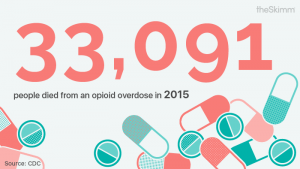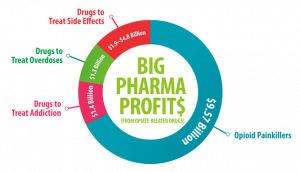Opioids are a class of drugs that include the illegal drug heroin, synthetic opioids such as fentanyl, and pain relievers available legally by prescription, such as oxycodone (OxyContin®), hydrocodone (Vicodin®), codeine, morphine, and many others. (DA.gov) Opioids are commonly used as pain relievers and are most commonly prescribed post surgery, significant  injury or use in cancer treatment. Opioids have become extremely common in our society; this has led to companies not needing to advertise opioids today because they are already widely known and used. However, in the early 2000’s with the recent release of OxyContin, ads were prominently aired on TV and found in magazines. This is one ad that aired in 1998 for OxyContin:
injury or use in cancer treatment. Opioids have become extremely common in our society; this has led to companies not needing to advertise opioids today because they are already widely known and used. However, in the early 2000’s with the recent release of OxyContin, ads were prominently aired on TV and found in magazines. This is one ad that aired in 1998 for OxyContin:
https://www.youtube.com/watch?v=Er78Dj5hyeI
It is clearly portrayed throughout the ad that OxyContin is the “best” drugs on the market. They quickly debunk the idea that opioids are addictive by saying only 1% of users become addicted to the drugs they are prescribed. This is blatantly a lie and misdirection of the issues at hand with opioid epidemic in America just taking off at the time. This is shown throughout the extensive number of people who became addicted and who abuse opioids after they are finished with their prescribed dosages. This is the reason I chose to take a closer look at opioids, their addictive potential alone warrants a deeper investigation. Also, I picked this ad in specific because of the harm that these ads caused the American people by exacerbating the epidemic.
The company that is makes and markets OxyContin is Perdue Pharma, they are a private pharmaceutical company which first started over 60 years ago. With their global partners they produce, develop, and research prescription and over the counter drugs. Purdue Pharma is a well established company in the healthcare industry and continues to develop new pharmaceuticals to this day as a leader in their industry. Their mission, as stated on their website, is “Purdue Pharma, a private company founded by physicians, is committed to advancing the medical care of patients with quality pharmaceutical products. We are known for our pioneering research in pain, a principal cause of human suffering. Today, we work with new partners on innovative healthcare solutions in many therapeutic areas.” Purdue Pharma seems like a well established company with good intentions for its consumers. However, they lied about the addiction potential in their ad blurring the line if their mission is genuine.
OxyContin, in this ad, is being mass marketed through T.V. to an audience of chronic pain sufferers and anyone seeking relief of existing pains. They mainly market to anyone who has undergone a major surgery, are undergoing cancer treatment, or have chronic pain. They use an M.D., Alan Spanos, to make the statements seem more valid and much more believable. They keep the ad formal and don’t show anyone or anything besides Spanos, this formal style helps Spanos seem credible. It doesn’t distract from Spanos so the center of attention is always on him, he is their clear selling point. Also, in the ad Spanos discredits the addictive potential of OxyContin; although we know it’s blatantly not true, because he’s an M.D. we are led on to trust him and automatically believe what he says. They trick the viewer through a simple argumentum ad verecundiam which lets them avoid facts and statistics and still be perceived well by the general audience.
OxyContin is composed of some fillers depending on dose but the main active ingredient in it is Oxycodone. Oxycodone is a semi synthetic opioid derived from poppies, mainly the Persian poppy. Oxycodone, like many opioids, causes an uplifted and euphoric effect as well as providing a numbing feeling to the entire body. In addition, oxycodone has an extremely high potential for abuse and is one of the most abused drugs in the opioid epidemic. The American Society of
Addiction Medicine (AMSA) posted an article in 2016 saying “Of the 20.5 million Americans 12 or older that had a substance use disorder in 2015, 2 million had a substance use disorder involving prescription pain relievers and 591,000 had a substance use disorder involving heroin.” Clearly more than 1% of users get addicted to OxyContin; furthermore, oxycodone acts as a gateway drug and many users seek a fix after their prescriptions end. Often thes users turn to heroin because it’s cheaper, more potent, and provides a similar effect. Although these figures are new statistics, it was significantly easier to get OxyContin at the time and its potency hasn’t changed since then, making it just as addictive then as it is now. Therefore this was a clear misdirection by Perdue to make sure they still made sales on OxyContin no matter the risk. With the opioid epidemic taking over in America
it’s clear to see why it erupted in the first place. Easy access to OxyContin and drugs like it at the time as well as advertising making these drugs seem nearly harmless led to an overall great perception of these opioids. This normalized what society thought of the drugs and quickly made it acceptable to be on these opioids and inevitably led to over use and addiction to opioids. It seems almost asinine to warp statistics like Perdue did, especially when they are so highly esteemed considering it has led to ruining so many lives. After misinforming their viewers on OxyContins extremely high addictive potential, Spanos goes on about how OxyContin is the “best” drug on the market for pain relief. He glorifies the drug an make it seem like a super cure to every issue, Spanos makes s
ure to emphasize that it’s the best drug more than once throughout the ad. Likewise, he increases his volume and tone when saying “best” to ensure that the audience understands how great OxyContin is.
After looking into OxyContin and oxycodone extensively it’s hard to understand what extent of pain someone would need to be in to need this drug. With the current opioid epidemic at hand it seems like a poor choice for someone to use OxyContin or any related drug at all. Due to a lack of public education as

well I believe that these opioids are still well received by the general populous. However, I do have personal experience with OxyContin because my twin was prescribed it and I witnessed firsthand its effects. He tore his PCL and had to have surgery to fix it, after the surgery he was prescribed OxyContin and Hydrocodone, a slightly less potent semi-synthetic opioid. He was in an excruciating amount of pain after and was confined to a recliner for over a month. The Oxy and Hydros were extremely effective in managing his pain; however, they also did get him somewhat high. This was apparent through his speech and general attitude. After about a month of using them to manage his pain he decided under his own fruition that he wanted to stop taking them. Although they helped him cope we could tell he was becoming addicted. He began to have trouble sleeping when not on them, not due to pain, and also began to crave them most of the time he wasn’t on them and even rarely when he was at the end of his dose. After stopping taking them he began to go through withdrawals, he was constantly craving them for the first two weeks off and immediately became irritable. Also, he continued to struggle with insomnia due to the withdrawal, when he did get sleep he would have night sweats. It was difficult seeing my brother go through this and it was clear that they were both extremely addictive drugs. Even though my brother stopped taking his prescription early, in about half the time he was prescribed, he still struggled with withdrawal. Clearly these opioids have an extremely high potential for addiction. I think it’s imperative that people understand the consequences that can occur from taking any form of opioid.
I generally wouldn’t recommend OxyContin or any derivative of it to anyone I knew. Being such a powerful drug the use of it would come down to how much pain the person was in. With such a high addictive potential I would only recommend an opioid to someone who was in an extreme amount of pain and needed something to cope. I believe that there is an array other options for pain relief before an opioid should be used. Any opioid has high abuse potential and is a double edged sword, it’s crucial to be educated and aware about drug use so be careful when taking any form of opioid.
https://www.youtube.com/watch?v=Er78Dj5hyeI
Abuse, N. I. (n.d.). Opioids. Retrieved November 15, 2017, from https://www.drugabuse.gov/drugs-abuse/opioids
Addiction Medicine, A. O. (2016). Opioid Addiction 2016 Facts and Figures. Retrieved November 05, 2017, from https://www.asam.org/docs/default-source/advocacy/opioid-addiction-disease-facts-figures.pdf
